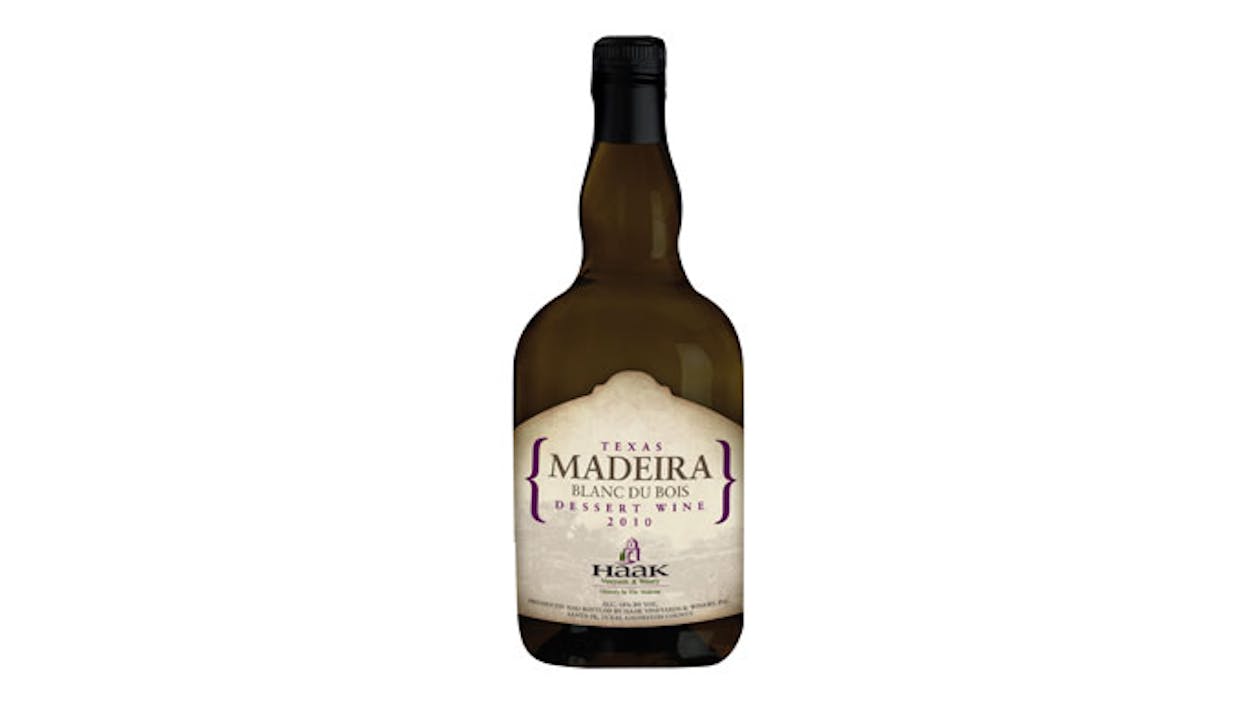THE WINE
Haak Vineyards & Winery, Texas Madeira from Blanc du Bois, 2010
WHO LIKES IT
Scott Ota, certified sommelier and manager at Austin’s Arro Restaurant. Ota was also recently named Texas’ Best Sommelier 2013 at the Texas Sommelier Conference.
THE GRAPE
Madeira is a classic fortified dessert wine named for a small archipelago along the coast of Portugal. It can range in style from dry to sweet and is primarily made from a blend of grapes, including Malvasia, Bual, Sercial, Verdehlo. Among its many notable characteristics, Madeira is known for its oxidative notes, a result of heated production: the wine is aged in barrels at temperatures above 140 degrees.
The Haak Madeira is made using similar methods, but with a single variety grape, Blanc du Bois. Blanc du Bois is a white hybrid grape developed in America.
“Normally, I am not the biggest fan of hybrid grapes, but you need to grow what works in your area. Along the hot and humid Gulf Coast, Blanc du Bois grows well, and the grape is resistant to most bacterial diseases,” says Ota. “I love Sherry and Madeira, and the fact that someone in Texas is doing something different in an oxidative environment is pretty cool. Full disclosure, I’m a total wine geek.”
WHY HE LIKES IT
“I love the creativity and the gusto to take a chance on an oxidative style of dessert wine. It’s not easy to do and I applaud Raymond Haak for doing it,” says Ota. “It represents the risks that Texas winemakers are taking to find out what works best for their respective areas and for making wines that can have a place at the dinner table. It still has that sweet fruit quality that many Texans enjoy, but it has a wonderfully nutty and fresh citrus finish that makes it different from your everyday glass.”
SUGGESTED PAIRINGS
“As a dessert wine, this is naturally something that goes well with something sweet after dinner: something creamy, fruity and nutty,” says Ota. “Arro serves a delicious lemon goat cheese tart with almonds that is a perfect pairing for this wine. But you could easily just sip it on its own.”
ON DOWN THE ROAD
“Texas is on the upswing,” says Ota. “As the vines age and as our winemakers get better and more experienced, our state is starting to produce wines that can be on par with the rest of the US and international markets. It’s exciting to see the growth of the industry and to start seeing Texas wines that have value.”
NOTE FROM THE WINEMAKER
Raymond Haak,Haak Vineyards and Winery:
The first Madeira I produced was from the Jacquez grape also known as Black Spanish or Lenoir. Jacquez originated from America and was exported to Madeira, the Island, when they were experiencing phylloxera, Oedium and other grapevine diseases. Jacquez is resistant to these diseases. So, with Texas growing Jacquez, there was a connection between Texas and Madeira, the Island.
But typically Madeira is made from white grape varieties, so I tried Blanc du Bois. The Madeira grape Malmsey is a distant cousin of the Muscat family of grapes and Blanc du Bois has Golden Muscat in its parentage. It was a natural choice.
Madeira Blanc du Bois exhibits aromas of peach, apricots and a hint of apples and figs on the nose, but on the palate, it fills the mouth with flavors of caramel, baked peach & apricot cobblers, with an overtone of vanilla to blanket the overall sensory experience.
Because of the nature of this wine, it will age well over 100 years. In fact, the cork will deteriorate in about 20 to 25 years and needs to be replaced (re-Engarafado or re-bottled). America, by the late 18th century, was one of the largest consumers of Madeira wine in the world. When prohibition came along, America could no longer buy Madeira wines, and it just died a natural death. America has amnesia, and has forgotten our love affair with Madeira.
You can find the Haak Madeira Blanc Du Bois at the winery as well as a number of retail locations across the state. Price: ~$40






